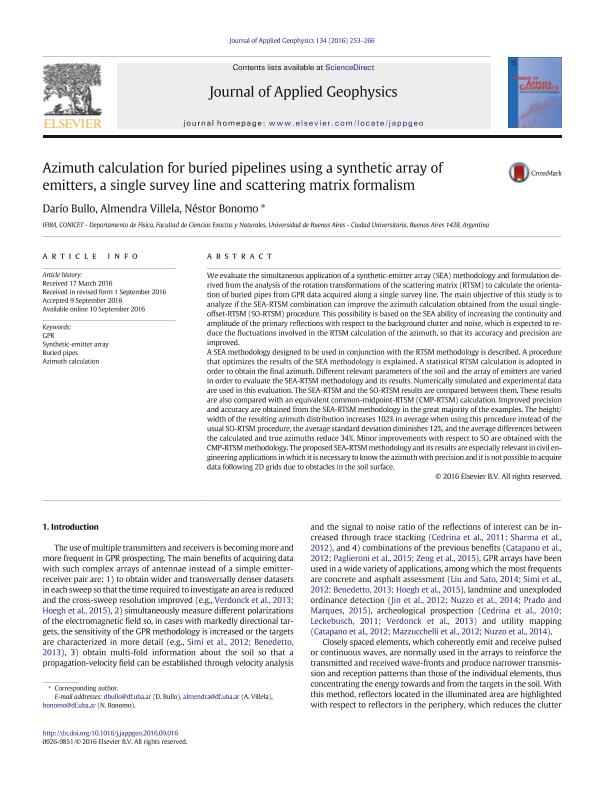Mostrar el registro sencillo del ítem
dc.contributor.author
Bullo, Darío Ezequiel

dc.contributor.author
Villela, Almendra
dc.contributor.author
Bonomo, Nestor Eduardo

dc.date.available
2018-06-19T16:29:11Z
dc.date.issued
2016-11
dc.identifier.citation
Bullo, Darío Ezequiel; Villela, Almendra; Bonomo, Nestor Eduardo; Azimuth calculation for buried pipelines using a synthetic array of emitters, a single survey line and scattering matrix formalism; Elsevier Science; Journal Of Applied Geophysics; 134; 11-2016; 253-266
dc.identifier.issn
0926-9851
dc.identifier.uri
http://hdl.handle.net/11336/49288
dc.description.abstract
We evaluate the simultaneous application of a synthetic-emitter array (SEA) methodology and formulation derived from the analysis of the rotation transformations of the scattering matrix (RTSM) to calculate the orientation of buried pipes from GPR data acquired along a single survey line. The main objective of this study is to analyze if the SEA-RTSM combination can improve the azimuth calculation obtained from the usual single-offset-RTSM (SO-RTSM) procedure. This possibility is based on the SEA ability of increasing the continuity and amplitude of the primary reflections with respect to the background clutter and noise, which is expected to reduce the fluctuations involved in the RTSM calculation of the azimuth, so that its accuracy and precision are improved. A SEA methodology designed to be used in conjunction with the RTSM methodology is described. A procedure that optimizes the results of the SEA methodology is explained. A statistical RTSM calculation is adopted in order to obtain the final azimuth. Different relevant parameters of the soil and the array of emitters are varied in order to evaluate the SEA-RTSM methodology and its results. Numerically simulated and experimental data are used in this evaluation. The SEA-RTSM and the SO-RTSM results are compared between them. These results are also compared with an equivalent common-midpoint-RTSM (CMP-RTSM) calculation. Improved precision and accuracy are obtained from the SEA-RTSM methodology in the great majority of the examples. The height/width of the resulting azimuth distribution increases 102% in average when using this procedure instead of the usual SO-RTSM procedure, the average standard deviation diminishes 12%, and the average differences between the calculated and true azimuths reduce 34%. Minor improvements with respect to SO are obtained with the CMP-RTSM methodology. The proposed SEA-RTSM methodology and its results are especially relevant in civil engineering applications in which it is necessary to know the azimuth with precision and it is not possible to acquire data following 2D grids due to obstacles in the soil surface.
dc.format
application/pdf
dc.language.iso
eng
dc.publisher
Elsevier Science

dc.rights
info:eu-repo/semantics/openAccess
dc.rights.uri
https://creativecommons.org/licenses/by-nc-sa/2.5/ar/
dc.subject
Azimuth Calculation
dc.subject
Buried Pipes
dc.subject
Gpr
dc.subject
Synthetic-Emitter Array
dc.subject.classification
Meteorología y Ciencias Atmosféricas

dc.subject.classification
Ciencias de la Tierra y relacionadas con el Medio Ambiente

dc.subject.classification
CIENCIAS NATURALES Y EXACTAS

dc.title
Azimuth calculation for buried pipelines using a synthetic array of emitters, a single survey line and scattering matrix formalism
dc.type
info:eu-repo/semantics/article
dc.type
info:ar-repo/semantics/artículo
dc.type
info:eu-repo/semantics/publishedVersion
dc.date.updated
2018-06-12T16:09:32Z
dc.journal.volume
134
dc.journal.pagination
253-266
dc.journal.pais
Países Bajos

dc.description.fil
Fil: Bullo, Darío Ezequiel. Universidad de Buenos Aires. Facultad de Ciencias Exactas. Departamento de Ecología, Genética y Evolución. Buenos Aires; Argentina
dc.description.fil
Fil: Villela, Almendra. Universidad de Buenos Aires. Facultad de Ciencias Exactas. Departamento de Ecología, Genética y Evolución. Buenos Aires; Argentina
dc.description.fil
Fil: Bonomo, Nestor Eduardo. Universidad de Buenos Aires. Facultad de Ciencias Exactas. Departamento de Ecología, Genética y Evolución. Buenos Aires; Argentina
dc.journal.title
Journal Of Applied Geophysics

dc.relation.alternativeid
info:eu-repo/semantics/altIdentifier/doi/http://dx.doi.org/10.1016/j.jappgeo.2016.09.016
Archivos asociados
